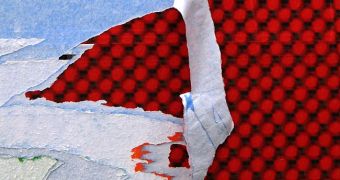You have a relatively simple task. Pulling off a piece of wallpaper glued onto a wall with the help of adhesive. Instinct tells us that it should pull off easily, in a single piece, however reality is very different. You should consider yourself lucky if you achieve this task without tearing off the wallpaper in several pieces. The fact is that the more you struggle to apply even pressure on the adhesive film, the greater the chance that you will break the wallpaper into a triangular pattern, such as that in the image.
Pedro Reis, a mathematician at Massachusetts Institute of Technology, has been studying the phenomenon for some time now and has just released his findings in the 30 March issue of Nature Materials. "There's basically no way to get around it. These are the cards the laws of physics have dealt us," writes Reis.
Film deformation
Reis reveals that while trying to yank a strip of wallpaper sticked on a particular surface, the applied force is distributed between breaking the adhesive force and deforming the two folds from which the piece originates. Eventually, this will create a strip of wallpaper that rips from the original piece in a triangular form, narrowing continually until the ruptures meet in a single point.
"The geometry of how the folds deform is extremely important. If you get rid of the adhesive properties of a film, though, then our theory doesn't apply," said Reis. The most important factors at play in such actions are the thickness of the paper sheet, the strength of the used adhesive and the force applied in order to separate them.
Experiments conducted by the researching team revealed that the speed of pulling greatly influenced the deformation pattern experienced by the wallpaper. Pulling slowly eventually reduced the deformation, however the ultimate result would only be a bigger triangular strip. "The moral of the story is 'go slow'," says Reis.
Applications
Reis believes that the research conducted by his team could be used in bendable electronics, such as stretchable electronic circuits for example. The adhesive properties of the thin polymer sheet, on which the metal structure is laid, are very important while trying to manipulate the mechanical properties of the deposited material.
Last but not least, the information from the study could be used by wallpaper manufacturers. "With duct tape, it has a mesh in it to prevent the deformation, so you always get a perfect rectangular strip. Maybe they should put a mesh in wallpaper from now on," adds Reis.

 14 DAY TRIAL //
14 DAY TRIAL //